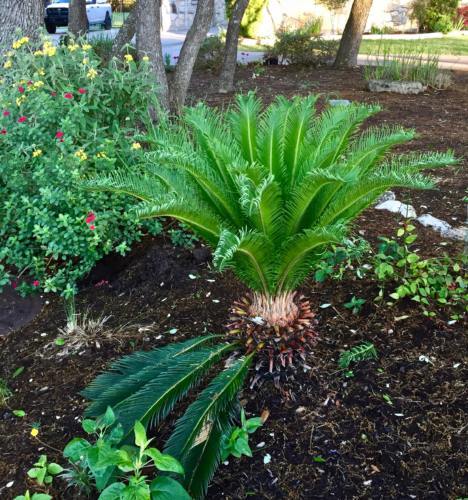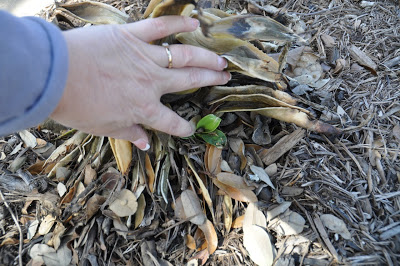How to prune sago palms after damaging winter…


One of my annual Mother’s Day treats — the day before Mother’s Day — is to spend the day on the Lady Bird Johnson Wildflower Center’s annual garden tour with my garden blogging friends.
This year’s tour included exceptional gardens that were previously featured during past tours. Since I had previously seen three of the gardens, it was a great opportunity to see how they had evolved over time.
Our first stop was an early invite to catch the morning sun in Tait Moring’s garden before the crowds arrived. Situated on a hilltop with an amazing canyon view, this garden is always a treat to visit. It includes classic elements and eclectic focal points — finely-honed view corridors and magnificent vistas. Several water features and a range of plants from xeric to native to tropical fill garden rooms with unique appeal.
This beautiful iron gate – which matches several others around the property, is the gateway to the beautiful view.
Strategically placed pottery and other objects serve as focal points around the garden.
Pots decorate patios, too.
I remembered the wonderful sculptural pruning of this pittosporum and after several more years of growth – it was even more beautiful than before.
More simple, understated pots with lush plants made a perfect match with the clean lines of the house.
Along the side of the house, these dramatic pots planted with yellow hesperaloe grab your attention.
In another vignette – this hardscaping elevates these pots with oversized agaves, both in height and in interest.
This ornate gate mirrors the other iron work on the property.
Pieces of glass are interspersed with the rocks in the wall, and a trio of pots adds more color to the display.
We couldn’t decide if this carving was Aztec or Southeast Asian in origin — but it was very cool.
And a field of native plants and wildflowers cascades down the hill.
Wonder what my tour mates are laughing about? I know!
This fence was definitely not meant to keep these beautiful blooms on one side of the fence or the other.
Pops of spring color.
I’m not sure this guy paid for a tour ticket!
This hammock, hidden down in the woods, called to my blogging buddy.
Intricate raised stone beds in the potager were filled with vegetables and flowers.
Artichokes on tour.
A small pocket of sun in a secret sitting area in the woods illuminates a blooming cactus.
After a long trek down the hillside and through the woods (no river), we found a beautiful Texas madrone tree. The Texas madrone is known for is its distinctive exfoliating bark. When the older layers come off, the new bark is smooth and can be white – like this one – or orange or even red. The madrone needs a xeric climate and very good drainage.
Another addition since our last visit – a beautifuldark-bottomed swimming pool. Subtle and simple, it fades into the backdrop of the garden.
A collection of tropical plants lines the stone wall and wood fence that serve as the backdrop for the pool.
This made me feel like I was in the Yucatan!
A delightful and fascinating garden, I left feeling peaceful and inspired.
I’ve long given up New Year’s Resolutions — but I do make some to-do lists. If I call them to-do lists, I seem to get around to them better!
This year I have a long garden to-do list. Perhaps committing it to eternal, world-wide view on my blog will help me check things off my list!
So, here goes:
1. Plant more trees outside the back fence in front of scrubby cedars. I love this smoke tree and planted one for a client this fall, wishing all the while that I had one to enjoy.
2. Have an a corner arbor build to showcase my tangerine cross vine and my wisteria. The cross vine winds along the fence and then climbs 20 feet up into a tree where I can’t see it. The wisteria spends most of its time hanging out on the opposite side of the fence — hiding from me — to be closer to the morning sun. A tall arbor would give them both plenty of room to keep growing — growing where I can enjoy them!
3. Replace the pride of Barbados that I lost over the last two winters. I love the explosion of color these trees bring in the late summer and I’ve missed mine. I vow to find some great hot spots for them to thrive.
4. I will buy more bigger starter plants this year. I’ve bemoaned the fact that my newer plants struggled to come back from harsh winters and scalding summers. Some years they even came back smaller than when I planted them! When I can, I want to invest in more established plants.
5. With too much on my plate, blogging and scrapbooking have waited in the wings too much this year. I love those creative outlets and want to give myself more opportunities for gathering inspiration from them.
6. Divide, divide, divide. I have irises, bi-color irises and lilies that really need dividing. In fact, they needed dividing this fall. This will be the year of dividing, replanting and sharing.
7. Prune, prune, prune. My cottage garden, cutting garden and hot southwest garden all suffered from overgrown-itis this year. Yes, the plants were all beautiful, but I know that pruned properly they would have complemented each other and showcased their individual characteristics better.
8. This year I will plant my bulbs before January … oh, wait … that means today! Yikes – better go find them and get to planting!
9. I WILL make homemade pesto from my basil “trees” this year. I say that every year when my basil gets out of hand — I mean stunning — but this year I really mean it.
10. And last, well, there never is a last, but I plan to dig up most of this and rebuild the dry creek with moss rock and other, larger stones. The recycled glass will come out and I will raise up the bed to help plants thrive there. With very little soil and a berm to avoid soil on the fence, the plants don’t get enough water and the soil just isn’t deep enough. The solution — protect the fence from rotting by putting hardy board against it and rock in the front to add good soil.
That’s the list — for now. As with everything in gardening – it’s organic and will change a thousand times over the next year. But it’s a good start and I feel good about making decisions to tackle some of my current and perpetual problems.
Guess we’ll see where I end up this time next year.
What’s on your garden resolution list for 2013?
Dead or Dormant?
Okay. So we’ve all been watching our gardens turn to mush and sticks and crackling paper. The colors du jour are brown and black and rotten. The kind of severe freeze damage we’ve had this winter has left us wondering what will live and what will die?
Is it dormant or is it dead?
We’re on the home stretch now – we only have a few more weeks with a danger of frost left. According to the USDA Hardiness Zone map for the Austin area, our average last frost occurs between March 1 and March 31. It’s typically the middle of March. I say the 15th, because I’m Type A and like my facts just so! (Mother Nature doesn’t always follow my rules, though – imagine that!)
So, it’s time to think about pruning.
First, assess the damage. If you scrape along the stem of most woody perennials you will be able to tell whether it is alive or not. Scratch and look for any signs of green. Normal pruning of most of our perennials will suffice if the plant is just dormant and not dead. Many of our woody plants like Lantanas and Tecoma Stans can be pruned entirely to the ground. Just make clean sharp cuts leaving about 6” of stem above the ground. If you want to leave some size and shape on the perennial, just prune back to healthy tissue. I will do that with my large Butterfly Bushes and my giant Duranta because I want to keep some of their size.
And don’t fertilize newly-pruned shrubs. They need to use all of their energy to begin new growth and fertilizing now will over-stress. Wait until later in the spring when they are established again.
But what do we do with succulents and agaves? Many of our aloes, agaves and their cousins just bit the dust in this freeze.
Ironic, isn’t it?
Like many Central Texas gardeners, I bought a lot of these plants to expand the drought tolerance palette of my garden in last summer’s scorching heat. Then this vicious and unusually-cold winter reduced many of them to pulp!
Freeze damaged succulents are usually a lighter color, almost white, soon after the freeze. Later, that part of the plant will wilt, and then turn black with rot. In some succulents, the affected part just eventually fall off. 
Even if you have rotten or dead leaves, if the bud is green and firm, the plant will likely to grow out and recover. And look closely before you start to dig — I was shocked to find two pups under this Agave desmettiana ‘variegata.’ I thought it was a goner for sure, but instead of losing one, I have just now found two new plants!
However, the parts that are damaged or dead never will recover, and here is the tricky part. For these types of plants, it is important to cut out only the dead parts, whether that is a whole leaf or only a part of one. It is a risk to prune living leaves on these kinds of plants because it invites infection, and when the plants are stressed out anyway, they are more susceptible to disease.
The same applies to palm trees: if the bud is fine and you see green in the center, the plant will probably live. Cut off dead or highly damaged leaves once it is warmer. Palms grow in the warm spring and through the summer, and may look much better by the end of the summer. Just give them time.
Cacti are very sensitive to pruning timing. While they may look really bad with their dying pads and stems, it is important to wait until it is really warm to prune them. Then dust the big cuts with sulfur to help dry out the cuts. Jointed cacti regenerate really well, but the columnar ones should to be cut back to the base or you will just end up with a permanent stump. If the plant is oozing, you can give it a quiet burial.
I’m off to do my assessment and start asking all my plants…
…”Are you dead or dormant?”
[/fusion_builder_column][/fusion_builder_row][/fusion_builder_container]
 It was quite a nice day here today. It got up to about 60 and was breezy but sunny.
It was quite a nice day here today. It got up to about 60 and was breezy but sunny.
Kallie had a friend over for a play date an they had a nice time swinging and enjoying the fresh air.
(No one in our house seemed bothered by cedar allergies today, thank goodness.)
So, while they were playing, I managed to prune back one big purple work bucket full of dead “stuff” from the Lantana, Indigo Spires and pruned back the roses.
I’ll have to do some research to learn how to prune the Lemon tree and the Peach tree…any suggestions out there?